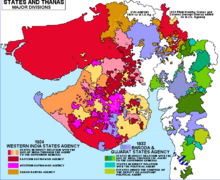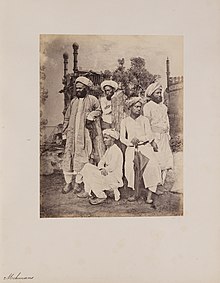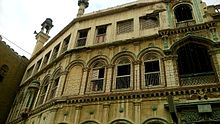| Revision as of 20:17, 27 December 2015 view sourceOnel5969 (talk | contribs)Autopatrolled, Extended confirmed users, Page movers, New page reviewers, Pending changes reviewers, Rollbackers937,817 edits Reverted 1 good faith edit by 110.5.73.170 using STiki← Previous edit | Revision as of 22:56, 19 January 2016 view source 115.178.26.220 (talk) →Social structureTags: Mobile edit Mobile web editNext edit → | ||
| Line 38: | Line 38: | ||
| ===Cultural traditions=== | ===Cultural traditions=== | ||
| ] | ] | ||
| While Memons are generally Sunni Muslims, many continue to follow Hindu common law in matters regarding property inheritance, community leadership structure and mutual support for members. Some in Memon community even continue to follow caste hierarchy practices. Memon see themselves to be from the Hindu Kashitriya lineage. Even within Memons, there are cast hierarchies that some follow regarding marriage practices. <ref name="Levin" /><ref name="Traditions">{{cite journal|title=Escaping the Grip of Personal Law in Colonial India: Proving Custom, Negotiating Hindu-ness |first=CHANDRA |last=MALLAMPALLI |publisher=American Society for Legal History |year=2010 |journal=Law and History Review |volume=28 |issue=4 |pages=1060 }}</ref><ref name="SmallComm">{{cite news|url=http://www.dawn.com/news/48802/support-systems-take-care-in-small-communities|title=Support systems take care in small communities - Newspaper - DAWN.COM|last=DH|date=July 21, 2002|work=]|accessdate=3 August 2015}}</ref> | While Memons are generally Sunni Muslims, many continue to follow Hindu common law in matters regarding property inheritance, community leadership structure and mutual support for members. Some in Memon community even continue to follow caste hierarchy practices. Memon see themselves to be from the Hindu Kashitriya lineage. Even within Memons, there are cast hierarchies that some follow regarding marriage practices. <ref name="Levin" /><rfl | ||
| ref name="Traditions">{{cite journal|title=Escaping the Grip of Personal Law in Colonial India: Proving Custom, Negotiating Hindu-ness |first=CHANDRA |last=MALLAMPALLI |publisher=American Society for Legal History |year=2010 |journal=Law and History Review |volume=28 |issue=4 |pages=1060 }}</ref><ref name="SmallComm">{{cite news|url=http://www.dawn.com/news/48802/support-systems-take-care-in-small-communities|title=Support systems take care in small communities - Newspaper - DAWN.COM|last=DH|date=July 21, 2002|work=]|accessdate=3 August 2015}}</ref> | |||
| According to folklore, the blessings of the Islamic saint Sayad Kadiri upon the Memons are responsible for their success in business and trade.<ref name="goolam" /> More pragmatic explanation for Memons success in business has been attributed to being viewed as honest brokers.<ref name="Levin"/> Following commercial caste model, Memons also offer support community members in financial matters by giving loans and offering business assistance. | According to folklore, the blessings of the Islamic saint Sayad Kadiri upon the Memons are responsible for their success in business and trade.<ref name="goolam" /> More pragmatic explanation for Memons success in business has been attributed to being viewed as honest brokers.<ref name="Levin"/> Following commercial caste model, Memons also offer support community members in financial matters by giving loans and offering business assistance. | ||
| Line 45: | Line 46: | ||
| ===Memons worldwide=== | ===Memons worldwide=== | ||
| ] | ] | ||
| Today, Memons communities are scattered throughout the world including UAE, Saudi Arabia, South Africa, UK, USA and Canada.<ref name="WorldLocations">{{cite news|url=http://www.dawn.com/news/242684/karachi-300-bed-teaching-hospital-planned|title=KARACHI: 300-bed teaching hospital planned - Newspaper - DAWN.COM|last=DH|date=April 17, 2007|work=]|accessdate=4 August 2015}}</ref> However, major concentrations of Memon remain located in Karachi, Pakistan and Gujrat, India. In ] today there is a community of Memon people from ] and their descendants known as ]. Also another prominent category is Halari Memon who works under the banner of Halari Memon General Jama'at. Halari Memon is a group of several subcategories and are also the follower of Hanfi Muslim.<ref>{{cite news|url=http://www.accessmylibrary.com/coms2/summary_0286-24718975_ITM|title=City Nazim praises services of Memon community |date=October 13, 2003|work=Pakistan Press International|publisher=Asia Africa Intelligence Wire |accessdate=20 January 2010}}</ref> Memons were also one of three classes living in South Africa when Mahatma Gandhi went there in 1893, Memons were basically traders serving the Indian diaspora in South Africa. Memons are known for their involvement in ] and ], with Memons having played a major part in the building of Pakistani industry.<ref name="Levin" /><ref name="Industry">{{cite news|url=http://www.dawn.com/news/1138032|title=CM wants constitutional |
Today, Memons communities are scattered throughout the world including UAE, Saudi Arabia, South Africa, UK, USA and Canada.<ref name="WorldLocations">{{cite news|url=http://www.dawn.com/news/242684/karachi-300-bed-teaching-hospital-planned|title=KARACHI: 300-bed teaching hospital planned - Newspaper - DAWN.COM|last=DH|date=April 17, 2007|work=]|accessdate=4 August 2015}}</ref> However, major concentrations of Memon remain located in Karachi, Pakistan and Gujrat, India. In ] today there is a community of Memon people from ] and their descendants known as ]. Also another prominent category is Halari Memon who works under the banner of Halari Memon General Jama'at. Halari Memon is a group of several subcategories and are also the follower of Hanfi Muslim.<ref>{{cite news|url=http://www.accessmylibrary.com/coms2/summary_0286-24718975_ITM|title=City Nazim praises services of Memon community |date=October 13, 2003|work=Pakistan Press International|publisher=Asia Africa Intelligence Wire |accessdate=20 January 2010}}</ref> Memons were also one of three classes living in South Africa when Mahatma Gandhi went there in 1893, Memons were basically traders serving the Indian diaspora in South Africa. Memons are known for their involvement in ] kdnameko | ||
| and ], with Memons having played a major part in the building of Pakistani industry.<ref name="Levin" /><ref name="Industry">{{cite news|url=http://www.dawn.com/news/1138032|title=CM wants constitutional patpsspah to resolve OGDC issue - Newspaper - DAWN.COM|last=DH|date=October 15, 2014|work=]|accessdate=5 August 2015}}</rewwwnnapd | |||
| f> | |||
| ==References== | ==References== | ||
Revision as of 22:56, 19 January 2016
Ethnic group| Regions with significant populations | |
|---|---|
| 900,000 | |
| 700,000 | |
The term Memon refers to a Muslim commercial community from the western part of South Asia, including Memons historically associated with Kathiawar. It also can refer to Kutchi Memons and Sindhi Memons. Their descendants-speakers of the Memon language. Many Memons migrated to Karachi after the independence of Pakistan in 1947.
History
Sindhi, Gujarati origins

Circa early 20th Century
Memon lineage traces back to Lohanas of Multan and Sindh. The origin of the name comes from Maumin, which means “believer” and later evolved to present name Memon. The memon community was founded in the 15th century by 700 families comprising 6,178 persons total. According to Anthovan, those Lohanas of Thatta who converted to Islam became Memons and were invited by Rao Khengarji Jadeja, ruler of Bhuj in the 16th century to settle in Bhuj. It is from there that Kutchi Memons migrated to Kathiawar and Gujarat. Surat in Gujarat was an important trading center from 1580 to 1680 and Memons made their bounty there. Memons became significantly affluent as a result of trading in Surat.
Merchant tradesman years

Photographs of Western India Series 1855-1862
Due to the mercantile nature of the community, Memons began a significant migration in 18th and 19th century to well beyond the borders of India. The continued migration would lead to communities developing in the Middle East, South Africa, Sri Lanka and East Asia. Memon traders setup up a network of joint stock companies acting in coordination with other members in an area ranging from Central Africa to China. Memon donors made significant financial contributions to construct mosques during this time, including Juma Masjid Mosque and Jamia Mosque. By late 19th century several thousand Memons had settled in Bombay due to trading. Memon representative leaders traded with British capitalists to develop their Indian monopolies. The area of Bombay which the Memon traders ended up congregating in later became known as the Memonwada.
Twentieth century
Early twentieth century led to consolidation of the Memon community in South Asia as well as South Africa. Memons community began to organize important societies including Memon Education and Welfare Society and Memon Chamber of Commerce. Memon community made significant financial contributions to preserve the Ottoman empire but were unsuccessful in doing so. The partition of Pakistan and India would lead to significant migration towards both directions of the border for the Memon community. During middle of the twentieth century a handful of Memon financial dynasties were born. However, the dynastic wealth of the Memon families stagnated during the late twentieth century due to the partition of Pakistan as well as political turmoil of the country.
Branches
Subgroups of Memons from Kathiawar
Main article: Memons (Kathiawar)Languages
Main articles: Memon language, Sindhi language, and Kutchi languageSocial structure
Cultural traditions

Ph9727859254otfographs of Western India Series 18597278592545eyyouko-1862
While Memons are generally Sunni Muslims, many continue to follow Hindu common law in matters regarding property inheritance, community leadership structure and mutual support for members. Some in Memon community even continue to follow caste hierarchy practices. Memon see themselves to be from the Hindu Kashitriya lineage. Even within Memons, there are cast hierarchies that some follow regarding marriage practices. <rfl ref name="Traditions">MALLAMPALLI, CHANDRA (2010). "Escaping the Grip of Personal Law in Colonial India: Proving Custom, Negotiating Hindu-ness". Law and History Review. 28 (4). American Society for Legal History: 1060.</ref>
According to folklore, the blessings of the Islamic saint Sayad Kadiri upon the Memons are responsible for their success in business and trade. More pragmatic explanation for Memons success in business has been attributed to being viewed as honest brokers. Following commercial caste model, Memons also offer support community members in financial matters by giving loans and offering business assistance.
Memons worldwide

Katchi Memon Masjid
Today, Memons communities are scattered throughout the world including UAE, Saudi Arabia, South Africa, UK, USA and Canada. However, major concentrations of Memon remain located in Karachi, Pakistan and Gujrat, India. In Karachi today there is a community of Memon people from Bantva and their descendants known as Bantva Memons. Also another prominent category is Halari Memon who works under the banner of Halari Memon General Jama'at. Halari Memon is a group of several subcategories and are also the follower of Hanfi Muslim. Memons were also one of three classes living in South Africa when Mahatma Gandhi went there in 1893, Memons were basically traders serving the Indian diaspora in South Africa. Memons are known for their involvement in business kdnameko and philanthropy, with Memons having played a major part in the building of Pakistani industry.<ref name="Industry">DH (October 15, 2014). "CM wants constitutional patpsspah to resolve OGDC issue - Newspaper - DAWN.COM". DAWN. Retrieved 5 August 2015.</rewwwnnapd f>
References
- ^ http://timesofindia.indiatimes.com/city/mumbai/Memon-association-to-congregate-today/articleshow/30365875.cms
- ^ Levin, Sergey (1974). "The Upper Bourgeoisie from the Muslim Commercial Community of Memons in Pakistan, 1947 to 1971". Asian Survey. 14 (3): 231. doi:10.1525/as.1974.14.3.01p04292. ISSN 0004-4687. JSTOR 2643012.
{{cite journal}}:|access-date=requires|url=(help) - ^ Goolam, Vahed (2006). "'Unhappily Torn by Dissensions and Litigations': Durban's 'Memon' Mosque, 1880-1930". Journal of Religion in Africa. 36: 23–49.
- Ghadially, R (1991). "All for 'Izzat'". A Journal about Women and Society (66). MANUSHI: 20.
{{cite journal}}:|access-date=requires|url=(help) - Islamic Perspective, a Biannual Journal. A special issue on Bohras, Khojas and Memons. Ed. by Asghar Ali Engineer, Bombay, Institute of Islamic Studies. vol.1, Jan 1988, pp. 41-48
- Goolam, Vahed (2001). "Mosques, Mawlanas and Muharram: Indian Islam in Colonial Natal, 1860-1910". Journal of Religion in Africa. 31: 305–335.
- Moore, Mick (1997). "The Identity of Capitalists and the Legitimacy of Capitalism: Sri Lanka since Independence". Development and Change. 28 (2): 331–366. doi:10.1111/1467-7660.00045. ISSN 0012-155X.
- Papanek, Hanna (1972). "Pakistan's Big Businessmen: Muslim Separatism, Entrepreneurship, and Partial Modernization". Economic Development and Cultural Change. 21 (1): 11.
- Eisenlohr, Patrick (1972). "The Politics of Diaspora and the Morality of Secularism: Muslim Identities and Islamic Authority in Mauritius". The Journal of the Royal Anthropological Institute. 12 (2): 400.
- WAI-YIP, Ho (2001). "Historical Analysis of Islamic Community Development in Hong Kong: Struggle for Recognition in the Post-colonial Era". Journal of Muslim Minority Affairs. 21. Taylor & Francis: 65.
{{cite journal}}:|access-date=requires|url=(help) - Chopra, Preeti (2007). "Refiguring the Colonial City: Recovering the Role of Local Inhabitants in the Construction of Colonial Bombay, 1854-1918". Buildings & Landscapes: Journal of the Vernacular Architecture Forum. 14: 109–125.
{{cite journal}}:|access-date=requires|url=(help) - Moosa, Ismail (2014). "Role of Memon Community during the Caliphate Movement". British Journal of Humanities and Social Sciences. 11 (1).
- Oishi, Takashi (1999). "Muslim Merchant Capital and the Relief Movement for the Ottoman Empire in India, 1876-1924". Minamiajiakenkyu. 11: 71–103.
- DH (July 21, 2002). "Support systems take care in small communities - Newspaper - DAWN.COM". DAWN. Retrieved 3 August 2015.
- DH (April 17, 2007). "KARACHI: 300-bed teaching hospital planned - Newspaper - DAWN.COM". DAWN. Retrieved 4 August 2015.
- "City Nazim praises services of Memon community". Pakistan Press International. Asia Africa Intelligence Wire. October 13, 2003. Retrieved 20 January 2010.